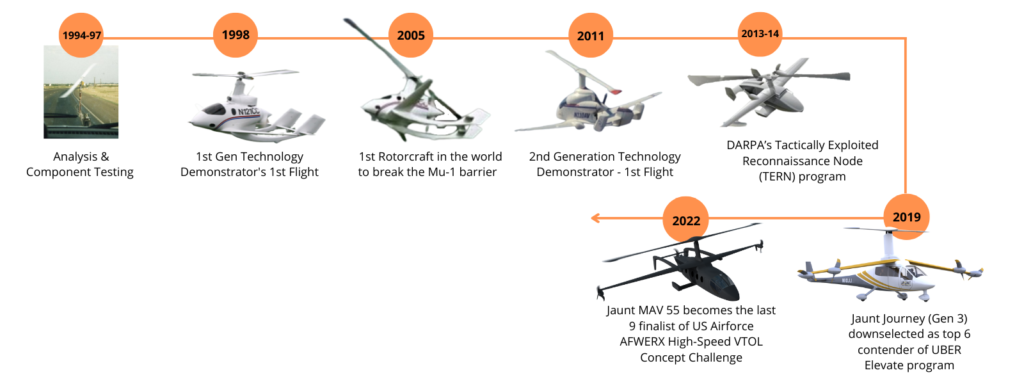JAUNT Journey
An all Electric Vertical Take-Off and Landing (eVTOL) aircraft produced by JAUNT Air Mobility.
THE HISTORY
Over two and half decades of research with over 1000 take offs and landings, Jaunt team has been flying manned aircrafts for over 24 years.
The aircraft combines the design from Helicopters and Sail planes along with distributed electric propulsion and uses its patented slowed-rotor compound (SRC) technology to slow down the rotor in cruise – it makes JAUNT eVTOL the safest eVTOL in the world.

- Full Electric aircraft with a range of 193 Kms with a cruise speed of 240km/hr and max speed 270 Km/hr.
- Slow Rotating Compound (SRC) which allows the roto to slow down when aircraft moves in cruise as the aircraft transitions into forward flight with wings providing most of the lift. Unlike Helicopters, SRC blade’s RPM can be controlled.
- Level Fly through a Tilting of the main mast. The tilting allow the aircraft to take off and land without the nose of the aircraft dipping forward while taking off or moving upwards while landing (ie like Helicopters). The center of gravity of the aircraft remains stable eliminating the need for baggage storage and passenger seating to be adjusted for CG balance.
- Counter rotating propellors and the elimination of tail rotor – brings down the noise level of the aircraft to 55dB (cruise) and 69 dB (while take off and landing) – making it one of the most silent aircrafts
- Even with a total power loss, the aircraft can autorotate to a controlled safe landing due to its high inertia rotor tip weights within 8 sq miles from a height of 1200 ft (20 sq km from a height of 365 m). It does not depend on unsafeballistic parachute.
- Use of Thermoplastics for major structures as well as the entire fuselage allows the aircraft to be much lighter & enables high volume production through automation with less touch labor and CapEx.
- Jaunt eVTOL will be certified under the existing “14 CFR Part 29 Category A” clause, meeting the highest level of safety in line with transport category aircraft. The latest FAA directive on eVTOL certification has put many other market leaders at risk of not being able to certify their aircraft under existing clauses and thereby delaying their programs by many years.